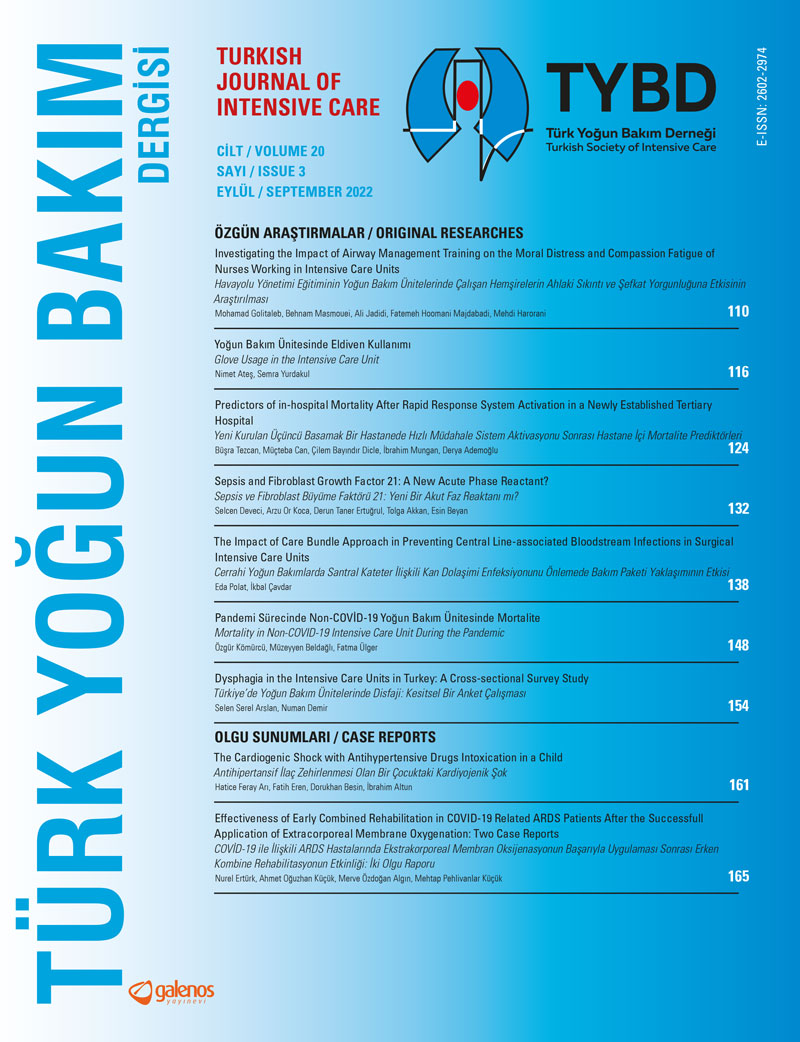Abstract
Objective:
This study aimed to compare the levels of fibroblast growth factor 21 (FGF 21) in patients with acute metabolic decompensation, sepsis and non-infectious inflammatory status using infection parameters and scoring systems.
Materials and Methods:
This cross-sectional study included 46 patients with sepsis and 29 patients with non-infectious inflammatory conditions in the case group. A total of 39 healthy volunteers were included in the control group. C-reactive protein, procalcitonin (PCT), sedimentation and FGF 21 levels were measured in all patients. Acute physiology and chronic health evaluation II and sequential organ failure assessment scores were also calculated.
Results:
FGF 21 levels in the patients in the case group were significantly higher than those in the patients in the control group (p˂0.001). A weak positive correlation was found between the FGF 21 and PCT levels (r=0.292, p=0.011). It was estimated that FGF 21 levels of 492.4 pg/mL and higher could predict the diagnosis of sepsis and non-infectious inflammatory status with 82.4% sensitivity and 80% specificity.
Conclusion:
FGF 21 can be considered an acute phase reactant in cases of infection, rising like PCT but not increasing in every acute condition.
Keywords: Fibroblast growth factor 21, sepsis, mortality
Introduction
Rapid response systems (RRS) have been widely implemented across world hospitals since the introduction of this concept in the 1990s (1,2). These systems include an afferent arm which is based on identifying non-intensive care unit (ICU) patients with clinical deterioration, especially those who are at an earlier stage (3). Rapid response teams (RRT) constitute the efferent arm of the RRS and mainly triage patients to intensive care units. These systems aim to prevent cardiac arrests and unexpected deaths (4).
Most of the studies about RRS aim to evaluate the utility of these systems and have focused on the comparison of patient outcomes before and after the implementation (5-7). Predictors of in-hospital mortality for patients who are subjects of a RRS activation are less studied. In this study we aimed to determine the predictors of in-hospital mortality for these patients and thereby improve the organization of the RRS.
Materials and Methods
This was a retrospective study conducted in a tertiary education and research hospital. The study protocol was reviewed and approved by the Ankara City Hospital Ethics Committee (IRB number: 72300690-799, date: 29.07.2019). Personal informed consent was not required.
RRT Description
Ankara City Hospital is a new tertiary education and research hospital with 3,810 beds in the capital of Turkey. It has been designed as a conglomerate of seven blocks; a main connecting block and six blocks serving as branch hospitals connected with the central block. The hospital has been functioning since February 2019 and a new RRS which is active at wards and other hospital areas except emergency and intensive care departments has been established since its opening. Each branch hospital has its own RRT. The team consists of a resident physician and two nurses from 8 am to 5 pm on week days, whereas it consists of a physician assistant and a nurseat nighttime and on weekends. Activation of the team can occur by any hospital staff member via a pager system. The criteria for RRT activation include the following: acute and persistent declining oxygen saturation (SpO2) <90%, acute and persistent changes in heart rate <40 or >120 bpm, mean arterial pressure (MAP) <65 mmHg and respiratory rate <8 and >28/min, acute mental status changes, unexplained agitation more than 10 minutes and staff concern for any other reason.
Patients
The records of RRT activations in two branch hospitals were reviewed from paper charts and electronic medical records between March 2019 and February 2020 (12 months). These two branch hospitals include 1,029 beds and care for adult patients with cardiovascular, pulmonary, oncologic, haematologic, gastroenterelogic, renal and urologic problems. Calls with missing or incomplete data were excluded.
Patient Variables
Demographic characteristics of patients, time of RRT activation, reasons for activation, initial cardiac rhythm, heart rate, MAP, pulse oximetry measured blood SpO2, arrival time of the RRT, parameters obtained from first blood gas (glucose, Na, K, pH, lactate) analysis and hemogram test (neutrophil, lymphocyte, red cell distribution width, platelet distribution width) were recorded. Blood samples were collected immediately after the first intervention as a routine procedure of our hospital. The study outcome was in-hospital mortality.
Statistical Analysis
All statistical analysis was performed using SPSS Statistics 18 (IBM corp., Inc., Chicago, IL, USA). Differences between patients who survived to discharge and those who did not were evaluated using chi-square or Fisher’s Exact tests for categorical variables and Student’s t-test or Mann-Whitney U test for continuous variables. Continuous variables were presented as mean ± standard deviation or median (minimum-maximum) and categorical data were summarized as percentages. Univariate logistic regression analyses were performed to examine the association between each predictor and in-hospital mortality separately. We also conducted a backward stepwise multivariate logistic regression to determine the independent predictors of mortality. A criterion of p<0.05 for entry was imposed in this procedure. We have introduced in the multivariate logistic regression analysis variables that are plausibly important based on theory even if the p-value was <0.05 in the univariate analysis (8). Model fit was assessed with the Hosmer-Lemeshow goodness-of-fit test. Odds ratios (ORs) for continuous variables were described using standardized ORs, which were associated with a one standard deviation change in the variable.
Results
Between March 1, 2019 and February 1, 2020, the RRT was activated 543 times resulting in an average of 45 activations per month. The most common reason for activation of the RRT was haemodynamic deterioration, followed by mental status changes. Respiratory deterioration was present in 17.3% of the activations. Twelve calls were excluded because of missing data. A final total of 531 patients who were the subjects of RRT activations were included in the analysis. Of these, 189 (35.6%) died during hospital admission. Patient and RRT event characteristics in patients who survived versus those who did not are shown in Table 1. Nonsurvivors were older (median age 64 years vs. 52 years), were more likely to be male (65.6% vs. 34.4%), were more likely to be admitted for cardiovascular, pulmonary and oncologic diseases and were more likely to trigger RRS activation during nighttime and weekend hours (NWH) than daytime hours (DH). Other reasons for hospital admission included a heterogeneous group of patients who were admitted for benign urologic and gastroenterologic reasons, the family members of patients and hospital staff. Vital signs were more likely to be abnormal in nonsurvivors with higher rates of bradycardia (heart rate <40 bpm; 62.4% vs. 19.3%), hypotension (MAP <65 mmHg; 78.8% vs. 46.5%), and hypoxia (SpO2 <90%; 83.6% vs. 33.6%). Survivors had lower rates of comorbidities (42.1% vs. 66.7%). Arrival time of the RRS was not different between survivors and nonsurvivors. The levels of potassium, lactate and neutrophil-to-lymphocyte ratio (NLR), red cell distribution width (RDW) and platelet distribution width (PDW) were significantly lower in survivors, while lymphocyte count was significantly higher in this group.
Predictors of in-hospital Mortality
Univariate logistic regression analysis demonstrated that activation of RRS by respiratory and haemodynamic triggers and during NWH, male sex, older age, cardiovascular, pulmonary and oncologic diseases as the main reason for hospital admission, respiratoryand multiple comorbidities, heart rate, bradycardia (<40 bpm) MAP, hypotension (MAP <65 mmHg), SpO2, hypoxia (SpO2 ≤90%), asystole and pulseless electrical activity (PEA) as initial rhythm, higher potassium, lactate, NLR, RDW levels andlower lymphocyte countwere significantly associated with mortality (Table 2).
Activation time and triggers of RRS, sex, age, reasons for hospital admission (cardiovascular, pulmonary and oncologic diseases), comorbidities (respiratory and multiple comorbidities), heart rate, MAP, SpO2, initial rhythms, potassium, lactate, NLR, RDW levels, lymphocyte count were included in the multivariate analysis. The final step of multivariate analysis retained activation time and triggers of RRS, reasons for hospital admission, SpO2, comorbidities, PEA as initial rhthyhm and potassium, lactate, NLR levels. Activation of RRS by respiratory and haemodynamic triggers and during NWH, oncologic diseases for hospital admission, low SpO2 levels, high NLR, potassium and lactate levels remained significant as predictors of mortality (Table 2).
Discussion
In this study we retrospectively evaluated the predictors of in-hospital mortality in patients who were the subjects of a RRS activation by using the paper and electronic records of patients. Our study demonstrates that independent predictors of in-hospital mortality were: 1) activation of RRS during NWH (factor associated with RRS); 2) respiratory and haemodynamic deterioration as RRS trigger, oncologic reasons for hospital admission, low SpO2 values(factors associated with clinical variables of the patients); and 3) NLR, potassium and lactate levels (factors associated with the first blood test of the patient).
RRTs are specialised teams that aims to immediately respond non-ICU patients experiencing clinical deterioration. They are the efferent arms of RRS, whereas the afferent arm is based upon hospital staff who determines the patient with acute physiological derangement and triggers the RRS activation. The composition of RRTs is tailored to some factors like aim of the team and resources of the hospital (4). The amount and level of experience of staff who are available in both arms of the RRS at NWH may differ from those available at DH (9). These working periods include fewer and less-experienced physicians coupled with reduced patient/nursing ratios on both the wards as well as the RRT. As a result; delays in RRT activations and mismanagement of deteriorating patient may occur more frequently at NWH. In our study RRT activation during NWH was an independent predictor of mortality. Our findings are consistent with a national registry study in the United States and a smaller study in Canada that reported increased mortality with overnight RRT activations (9,10). Our study differs from these reports by comparing DH and NWH. Nighttime and weekend hours resemble each other in some key aspects including fewer andless-experienced staff members. The problem in our hospital may arise from the limited staff resource of this newly established hospital and use of paper based observation charts in wards. The afferent and efferent arms of RRS can be improved by strengthening the staff in size and competence at NWH and moving from paper based observation charts to electronic medical records (11).
Other predictors of mortality were respiratory and haemodynamic deterioration as RRS trigger, oncologic reasons for hospital admission, low pulse oximetry values, high potassium and lactate levels after RRS activation. This finding is not surprising considering that most of these factors, including respiratory and haemodynamic triggers, low pulse oximetry values and high lactate levels are associated with impairment of tissue oxygenation. Shappell et al. (12) also reported that patients who died more likely to have a respiratory or cardiovascular triggers for RRS activation in their study. Hyperkalemia decreases the resting membrane potential of the myocardium, thereby myocardial cell conduction velocity decreases and rate of repolarization increases (13). McMahon et al. (14) demonstrated that potassium level is robustly associated with mortality risk even at moderate increases above normal. This is the most possible explanation for potassium-mortality association.
Cancer and its treatment usually lead to diminished physiological reserve (15). Almost one third of our study population was cancer patients and 53.7% of these patients did not survive after RRS activation. This result is in line with previous two studies suggesting that cancer patients have worse outcomes following in-hospital cardiac arrest and hematologic oncology patients for whom the RRS was activated have high rates of subsequent ICU admission and mortality.
Interestingly, our results indicate that a MAP did not predict mortality whereas pulse oximetry did. Although MAP is commonly used as a surrogate of organ perfusion (16); it provides a reasonable estimate of the adequacy of organ perfusion as long as venous pressure and vascular resistance remains constant (17,18). Therefore a target of keeping MAP ≥65 mmHg should be individualized based on comorbidities (16). Besides this; it is known that peripheral circulation is the first to reflect a disturbance of the microcirculation and pulse oximeters generally have been shown to be accurate incritically ill patients (19,20). Ebmeier et al. (21) reported that there was no overall statistically significant bias in paired SpO2/SaO2 measurements in critically ill patients. Therefore we think that macrohemodynamic parameters like MAP and heart rate (as a determinant of cardiac output) may be less predictive of mortality than SpO2 which provides a measure of microvascular oxygenation, especially if they are evaluated with cut off points.
To our knowledge, this is the first study to demonstrate the predictive value of NLR in patients receiving RRS activation. NLR is a helpful biomarker associated with the severity and prognosis of many conditions including cardiovascular diseases, certain types of cancers and sepsis (22). It is inexpensive, easily accessible and can be used for assessing the systemic inflammatory state as well as physiological stress (23).
It is obvious that ICU resources are scarce and costly. Therefore triage decisions during RRT activations should also give priority for patients with greater benefit (24). Patients who are less likely to survive or likely to have morbidity if not admitted to the ICU should be preffered (25). Furthermore some patients can benefit from “comfort care only” orders which should be discussed with patients and/or families. Our results provide more evidence for appropriate and quick triage decisions since most of the factors we found to predict mortality can be simply assessed at bedside using patients’ charts and blood gas analysis. On the other hand; NLR is calculated from a complete blood count test and can be obtained in a short period of time. We think that it can be used for appropriateness of triage decisions as well as avoiding futile interventions at the end of life.
There are several limitations of this study. First, this was a retrospective observational study and has the limitations inherent in this study design. Second the sample size was relatively small compared to other published studies (12,26,27). On the other hand, we analyzed some predictive factors of mortality in the first hour after RRS activation, which may be the most important but not the only ones.Other factors that affect prognosis, but may appear in the following hours and days, were not analyzed.
Conclusion
In conclusion, we found that the most important mortality risk factors in patients for whom the RRS was activated were presence of respiratory or haemodynamic triggers, activation of RRS during NWH, oncologic reasons for hospital admission, low SpO2 values, high NLR, potassium and lactate levels. Since our findings demonstrate some weakness in the current RRS of our hospital; overnight staff, both in RRT and hospital wards, should be trained and empowered. Besides this; SpO2, potassium and lactate levels can guide triage decisions which is usually a challenging and stressful duty. We also found NLR as a predictive of mortality that may help to reevaluate the appropriateness of these decisions.
Ethics
Authorship Contributions
References
- Singer M, Deutschman CS, Seymour CW, Shankar-Hari M, Annane D, Bauer M, et al. The Third International Consensus Definitions for Sepsis and Septic Shock (Sepsis-3). JAMA 2016;315:801-10.
- Hotchkiss RS, Karl IE. The pathophysiology and treatment of sepsis. N Engl J Med 2003;348:138-50.
- Genga KR, Russell JA. Update of Sepsis in the Intensive Care Unit. J Innate Immun 2017;9:441-55.
- Li X, Zhu Z, Zhou T, Cao X, Lu T, He J, et al. Predictive value of combined serum FGF21 and free T3 for survival in septic patients. Clin Chim Acta 2019;494:31-7.
- van Engelen TSR, Wiersinga WJ, Scicluna BP, van der Poll T. Biomarkers in Sepsis. Crit Care Clin 2018;34:139-52.
- Marik PE. Procalcitonin is an essential biomarker for hydrocortisone, ascorbic acid, and thiamine (HAT) therapy in patients with sepsis. Crit Care 2019;23:151.
- Suárez-Santamaría M, Santolaria F, Pérez-Ramírez A, Alemán-Valls MR, Martínez-Riera A, González-Reimers E, et al. Prognostic value of inflammatory markers (notably cytokines and procalcitonin), nutritional assessment, and organ function in patients with sepsis. Eur Cytokine Netw 2010;21:19-26.
- Reinhart K, Bauer M, Riedemann NC, Hartog CS. New approaches to sepsis: molecular diagnostics and biomarkers. Clin Microbiol Rev 2012;25:609-34.
- Tomasiuk R, Mikaszewska-Sokolewicz M, Szlufik S, Rzepecki P, Lazowski T. The prognostic value of concomitant assessment of NT-proCNP, C-reactive protein, procalcitonin and inflammatory cytokines in septic patients. Crit Care 2014;18:440.
- Dias AT, Matta Pde O, Nunes WA. Índices de gravidade em unidade de terapia intensiva adulto: avaliação clínica e trabalho da enfermagem [Severity indexes in an adult intensive care unit: clinical evaluation and nursing work]. Rev Bras Ter Intensiva 2006;18:276-81.
- Luo XP, Wang HH, Hu SF, Wu SJ, Xie GH, Cheng BL, et al. [Comparison of three different organ failure assessment score systems in predicting outcome of severe sepsis]. Zhonghua Wai Ke Za Zhi 2009;47:48-50.
- Trancă S, Petrișor C, Hagău N, Ciuce C. Can APACHE II, SOFA, ISS, and RTS Severity Scores be used to Predict Septic Complications in Multiple Trauma Patients? J Crit Care Med (Targu Mures) 2016;2:124-30.
- Türe M, Memiş D, Kurt I, Pamukçu Z. Predictive value of thyroid hormones on the first day in adult respiratory distress syndrome patients admitted to ICU: comparison with SOFA and APACHE II scores. Ann Saudi Med 2005;25:466-72.
- Goetz R, Beenken A, Ibrahimi OA, Kalinina J, Olsen SK, Eliseenkova AV, et al. Molecular insights into the klotho-dependent, endocrine mode of action of fibroblast growth factor 19 subfamily members. Mol Cell Biol 2007;27:3417-28.
- Itoh N, Ohta H, Konishi M. Endocrine FGFs: Evolution, Physiology, Pathophysiology, and Pharmacotherapy. Front Endocrinol (Lausanne) 2015;6:154.
- BonDurant LD, Ameka M, Naber MC, Markan KR, Idiga SO, Acevedo MR, et al. FGF21 Regulates Metabolism Through Adipose-Dependent and -Independent Mechanisms. Cell Metab 2017;25:935-44.e4.
- Xie T, Leung PS. Fibroblast growth factor 21: a regulator of metabolic disease and health span. Am J Physiol Endocrinol Metab 2017;313:E292-302.
- Suassuna PGA, de Paula RB, Sanders-Pinheiro H, Moe OW, Hu MC. Fibroblast growth factor 21 in chronic kidney disease. J Nephrol 2019;32:365-77.
- Su X, Kong Y, Peng D. Fibroblast growth factor 21 in lipid metabolism and non-alcoholic fatty liver disease. Clin Chim Acta 2019;498:30-7.
- Olszanecka-Glinianowicz M, Madej P, Wdowczyk M, Owczarek A, Chudek J. Circulating FGF21 levels are related to nutritional status and metabolic but not hormonal disturbances in polycystic ovary syndrome. Eur J Endocrinol 2015;172:173-9.
- Gariani K, Drifte G, Dunn-Siegrist I, Pugin J, Jornayvaz FR. Increased FGF21 plasma levels in humans with sepsis and SIRS. Endocr Connect 2013;2:146-53.
- Feingold KR, Grunfeld C, Heuer JG, Gupta A, Cramer M, Zhang T, et al. FGF21 is increased by inflammatory stimuli and protects leptin-deficient ob/ob mice from the toxicity of sepsis. Endocrinology 2012;153:2689-700.
- Li X, Zhu Z, Zhou T, Cao X, Lu T, Liang Y, et al. Early increases in serum FGF21 levels predict mortality of septic patients. Cytokine 2018;111:428-33.
- American College of Chest Physicians/Society of Critical Care Medicine Consensus Conference: definitions for sepsis and organ failure and guidelines for the use of innovative therapies in sepsis. Crit Care Med 1992;20:864-74.
- Nasimfar A, Sadeghi E, Karamyyar M, Manesh LJ. Comparison of serum procalcitonin level with erythrocytes sedimentation rate, C-reactive protein, white blood cell count, and blood culture in the diagnosis of bacterial infections in patients hospitalized in Motahhari hospital of Urmia (2016). J Adv Pharm Technol Res 2018;9:147-52.
- Wang S, Chen D. [The correlation between procalcitonin, C-reactive protein and severity scores in patients with sepsis and their value in assessment of prognosis]. Zhonghua Wei Zhong Bing Ji Jiu Yi Xue 2015;27:97-101.
- Camporez JP, Jornayvaz FR, Petersen MC, Pesta D, Guigni BA, Serr J, et al. Cellular mechanisms by which FGF21 improves insulin sensitivity in male mice. Endocrinology 2013;154:3099-109.
- Véniant MM, Komorowski R, Chen P, Stanislaus S, Winters K, Hager T, et al. Long-acting FGF21 has enhanced efficacy in diet-induced obese mice and in obese rhesus monkeys. Endocrinology 2012;153:4192-203.
- Yu Y, He J, Li S, Song L, Guo X, Yao W, et al. Fibroblast growth factor 21 (FGF21) inhibits macrophage-mediated inflammation by activating Nrf2 and suppressing the NF-kB signaling pathway. Int Immunopharmacol 2016;38:144-52.
Copyright and license
Copyright © 2022 The Author(s). This is an open access article distributed under the Creative Commons Attribution License (CC BY), which permits unrestricted use, distribution, and reproduction in any medium or format, provided the original work is properly cited.






















